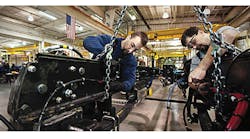Strong consumer demand driven by job growth should lead to increased manufacturing production through 2017, according to a new forecast by the MAPI Foundation, the research affiliate of the Manufacturers Alliance for Productivity and Innovation.
The group predicts that GDP will expand 2.9% in 2016 and 2.7% in 2017. GDP growth for 2018 is anticipated to be 2.5%. All estimates are above the anticipated 2.4% GDP growth for the U.S. economy in 2015.
During the next few years, manufacturing production is also expected to outpace the forecast of 1.8% growth in 2015. Output is anticipated to advance by 2.6% in 2016 and 3.0% in 2017. The foundation predicts 2.8% growth in 2018.
The November 2015 reports offers a five-year horizon in which GDP is expected to average just under 2.6% growth from 2016 to 2020 and manufacturing production to average 2.6% growth during that time frame.
"There are strong deflationary pressures that are spreading, such as lower global energy prices, China's economic restructuring, and a forecast for slow price recovery in commodities," said MAPI Foundation chief economist Daniel J. Meckstroth, Ph.D. "Also, we are not anticipating negative shocks such as the harsh winter and California port strikes to repeat themselves in 2016. Strong domestic demand buffers the United States from the rest of the world, where global manufacturing continues to slow.
"We expect a modest acceleration in manufacturing growth over the next two years before it decelerates," he added. "Consistently strong job growth is driving the economy. New workers mean more income, which translates into more spending."
Still, Meckstroth sees some challenges. "The strong dollar will reduce GDP growth by 0.7% in 2015 and by 0.4% in 2016 and 2017, with a negative effect on inventories and net exports."
Other predictions include:
--Non-high-tech manufacturing production is expected to increase 2.1% in 2016, 3.0% in 2017 and 2.6% in 2018.
--High-tech manufacturing production, which accounts for approximately 5% of all manufacturing, is anticipated to grow 4.3% in 2016, 5.7% in 2017 and 5.5% in 2018.
--Investment in equipment is for growth of 6.6% in 2016, 6.2% in 2017 and 4.7% in 2018.
--Expenditures for information processing equipment are anticipated to increase by 7.2% in 2016, 7.4% in 2017 and 7.3% in 2018.
--Industrial equipment expenditures will advance 8.3% in 2016, 7.9% in 2017 and 3.5% in 2018.
--Spending on transportation equipment is forecast to increase 3.9% in 2016, 1.1% in 2017 and 1.2% in 2018.
--Spending on nonresidential structures is anticipated to increase by 5.6% in 2016 before decelerating to 5.1% growth in 2017 and 3.1% in 2018.
--Residential fixed investment is forecast to gain by 10.2% in 2016, 9.7% in 2017 and 4.0% in 2018. Housing starts in 2016 will hit 1.3 million. In 2017 it will move to 1.4 million in 2017 and 1.5 million in 2018.
--Exports are anticipated to increase 3.0% in 2016, 4.0% in 2017 and 5.0% in 2018.
--Imports are expected to grow 5.6% in 2016, 7.5% in 2017 and 4.8% in 2018.
The MAPI Foundation forecasts overall unemployment to average 5.0% in 2016, 2017, and 2018. The outlook is for an increase of 46,000 manufacturing jobs in 2015, a drop from 124,000 anticipated in the August report. Meckstroth envisions 100,000 manufacturing jobs to be added in 2016, a slight increase from 94,000 in the previous report, and 110,000 to be gained in 2017, a significant advance from 30,000 in the August forecast.



